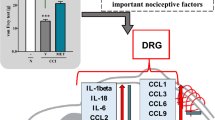Abstract
Purpose
The study compared analgesic efficacy of intrathecally administered ketorolac tromethamine (K) and morphine hydrochlorïde (M) (in equimolar doses) in the chronic neuropathic pain model, induced by chronic constriction injury (CCI) of the sciatic nerve in rat.
Methods
Male Sprague-Dawley rats (n = 30) were anaesthetized with halothane and an intrathecal catheter was inserted to the mid-lumbar level of the spinal cord. On the 5th postoperative day, rats were anaesthetized with halothane and four ligatures were loosely applied around the right sciatic nerve. Seven days later, those animals were randomly divided into three groups and were injected with either saline, M (20 nmoles) or K (20 nmoles). Two pain responses (foot-withdrawal delay and hind paw elevation time) were measured on both sides using the radiant heat method. Further, thermal (“cold”) allodynia was assessed by measuring of the total time of hind paw elevation in animals placed on the cold metal plate.
Results
Twenty nmoles of M and K injected intrathecally produced decrease of differential pain score calculated for both measured responses (hind paw withdrawal and hind paw elevation), compared with saline injected animals (P < 0.05). The reduction in pain response produced by K was less (P < 0.05) than the reduction in pain response observed in the animals receiving intrathecal M. Measurement of cold allodynia revealed that the animals in M and K injected groups demonstrated decreases in the total hind paw elevation lime, when compared with saline-injected animals (P < 0.05).
Conclusion
M and K produced hypoalgesia after intrathecal administration in rats with CCI, with M being more potent than K at an equimolar dose range. The analgesic effect of K was equal to equimolar doses of M for alleviation of cold allodynia.
Résumé
Objectif
Comparer l’efficacité analgésique sous-archnoïdienne de la trométhamine de kétorolac (K) à celle de l’hydrochlorure de morphine (M) (à doses équimolaires) sur un modèle de douleur neuropathique chronique induite par une lésion constrictive chronique (LCC) du nerf sciatique chez le rat.
Méthodes
Trente rats Sprague-Dawley ont été anesthésiés à l’halothane et un cathéter sous-arachnoïdien inséré au niveau lombaire rachidien moyen. Cinq jours plus tard, quatre ligatures ont été nouées lâchement autour du nerf sciatique droit. Sept jours plus tard, ces animaux ont été répartis aléatoirement entre trois groupes et ont reçu soit du sol. physiologique, soit M (20 nmoles), soit K (20 nmoles). Deux réponses à la douleur (l’intervalle jusqu’au retrait de la patte, et la durée de l’élévation de la patte de derrière) ont été mesurées bilatéralement avec la méthode de la chaleur radiante. En outre, l’allodynie thermique («froide») a été évaluée en mesurant la durée totale de l’élévation de la patte de derrière chez les animaux placés sur la plaque de métal froide.
Résultats
L’injection sous-arachnoïdienne de 20 nmoles de M et de K a provoqué une baisse des scores de douleurs différentiels calculés pour les deux réactions mesurées (retrait et élévation de la patte de derrière) comparativement aux animaux qui avaient reçu le sol. physiologique (P < 0,05). La réduction de la réponse douloureuse produite par K était moindre (P < 0,05) que celle produite par M. La mesure de l’allodynie au froid a révélé que les animaux des groupes M et K présentaient des diminutions de la durée totale d’élévatoin de la patte de derrière comparativement aux groupe qui avait reçu du sol. physiologique (P < 0,05).
Conclusion
Chez le rat porteur de LCC, l’administration sous-arachnoïdienne de M et de K a produit de l’hypoalgésie, mais M était plus puissant pour une gamme de doses équimolaires. Pour l’atténuation de l’allodynie au froid, à des doses équimolaires, l’effet analgésique de K était égal à celui de M.
Similar content being viewed by others
References
Malmberg AB, Yaksh TL. Hyperalgesia mediated by spinal glutamate or substance P receptor blocked by spinal cycooxygenase inhibition. Science 1992; 257: 1276–9.
Malmberg AB, Yaksh TL. Antinociceptive effects of intrathecal non-steroidal anti-inflammatory drugs (NSAIDs) on tonic pain behavior in rats. Anesthesiology 1992; 77: A732.
Malmberg AB, Yaksh TL. Pharmacology of the spinal action of ketorolac, morphine, ST-91, U50488H, and L-PIA on the formalin test and an isobalographic analysis of the NSAID interaction. Anesthesiology, 1993; 79: 270–81.
Uda R, Horiguchi S, Ito S, Hyodo M, Hayaishi O. Nociceptive effects induced by intrathecal administration of prostaglandin D2, E2, or F2α to conscious mice. Brain Res 1990; 510: 26–32.
Brocks DR, Jamali F. Clinical pharmacokinetics of ketorolac tromethamine. Clin Pharmacokinel 1992; 23: 415–27.
Zimmermann M. Ethical guidlines for investigations of experimental pain in conscious animals (Editorial). Pain 1983; 16: 109–10.
Yaksh TL, Rudy TA. Chronic catheterization of the spinal subarachnoid space. Physiol Behav 1976; 17: 1031–6.
Bennett GJ, Xie Y-K. A peripheral mononcuropathy in rat that produces disorders of pain sensation like those seen in man. Pain 1988; 33: 87–107.
Parris WCV, Janicki PK, Johnson BWJr, Mathews L. The behavioral and biochemical effect of pulsating magnetic field treatment (PMFT) on chronic pain produced by chronic constriction injury of sciatic nerve in rat. Analgesia 1994; 1: 57–64.
Miranda HF, Sierralta F, Pinardi G. Previous administration of indomethacin or naloxone did not influence ketorolac antinociception in mice. Anesth Analg 1993; 77: 750–3.
Maves TJ, Pechman PS, Meller ST, Gebhart GF. Ketorolac potentiates morphine antinociception during visceral nociception in the rat. Anesthesiology 1994; 80: 1094–101.
Uphouse LA, Welch SP, Ward CR, Ellis EF, Embrey JP. Antinociceptive activity of intrathecal ketorolac is blocked by the k-opioid receptor antagonist, nor-binaltorphimine. Eur J Pharmacol 1993; 242: 53–8.
Author information
Authors and Affiliations
Corresponding author
Rights and permissions
About this article
Cite this article
Parris, W.C.V., Janicki, P.K., Johnson, B. et al. Intrathecal ketorolac tromethamine produces analgesia after chronic constriction injury of sciatic nerve in rat. Can J Anaesth 43, 867–870 (1996). https://doi.org/10.1007/BF03013041
Accepted:
Published:
Issue Date:
DOI: https://doi.org/10.1007/BF03013041




